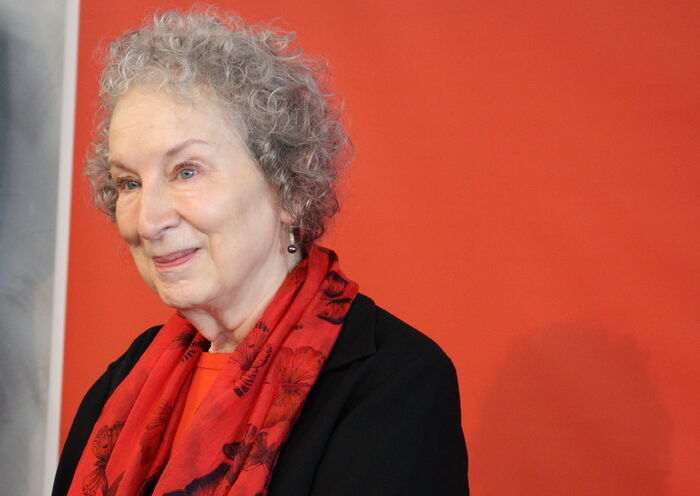The Testaments: Great expectations fall flat in this return to Gilead
Grace Robinson finds this eagerly-anticipated sequel more pacy than profound

It was hailed as the literary event of the year; Waterstones hadn’t seen midnight queues like it since the peak of Potter. Late-night launches took place in bookshops nationwide and Lily James led a live event staged at the National Theatre and streamed to cinemas all over the country. Fans of The Handmaid’s Tale held their breath, waiting for the moment they could get their hands on a copy of the sequel to this modern classic and finally have their thirty-year-old questions answered. Three decades after the publication of The Handmaid’s Tale, Margaret Atwood returns to her dystopian world of Gilead, and expectations are high. The only question is, does The Testaments live up to the hype?
“It seems story satisfaction for fans of the franchise has overshadowed the authentic writing project of The Testaments”
The novel essentially feels like a response, a reply. When asked why she decided to return to the dark patriarchal theocracy she created over thirty years ago, Atwood cited one of her inspirations as ‘the world we have been living in’. The book gives her a chance to reflect and inflect her concerns which have developed and persisted over the last thirty years. But it is also an acknowledgement of the questions of her dedicated readers. What happened to Offred, heroine of The Handmaid’s Tale, after she disappeared to an unknown fate in the back of a van? Was she able to escape Gilead, did she reunite with her daughter? Onstage at the live event on The Testaments’ publication day, Atwood teased her readers: ‘All your questions will be answered,’ she twinkled.
The sequel, set around 15 years after The Handmaid’s Tale, sees a departure from the central Handmaid figure of Offred, and is instead told through the three separate narratives of radically different characters: the formidable Aunt Lydia, risen to utmost power within the ranks of Gilead and ready to exact revenge on those who created it; Agnes, a Gilead-grown girl who has only known life inside the theocracy; and Daisy, a young Canadian suddenly forced to face the reality of the next-door dictatorship she has only ever studied at school.
The accounts of the three women are presented as testimonies – or indeed Testaments – and are dissected during a Symposium at the end in the same style as the first novel, underlining a strong emphasis on subjective history, women’s stories and collective memory once again. The importance of literacy among women and girls is made imperative. Aunt Lydia’s writing drives the narrative, adopting a lofty yet highly self-reflective tone in a prose which often addresses her future reader: “I picture you as a young woman, bright, ambitious. You’ll be looking to make a niche for yourself in whatever dim, echoing caverns of academia still exist by your time. I situate you at your desk, your hair tucked back behind your ears, your nail polish chipped - for nail polish will have returned, it always does. You’re frowning slightly, a habit that will increase as you age. I hover behind you, peering over your shoulder: your muse, your unseen inspiration, urging you on.”
“Character insight and depth have been sacrificed, leaving the novel feeling more superficial than sophisticated”
The other narrators’ sections are less eloquent. The intense introspection and clever language play of Offred’s musings is replaced by heavy dialogue and younger voices which give the novel a distinctly Young Adult feel. The Testaments is markedly more plot-driven than its predecessor, which makes for a page-turning read but lacks Atwood’s trademark literary wizardry. The world of Gilead is opened up to the reader, the corrupt inner-workings previously deprived from the account of oppressed Offred are revealed through the now-mighty Aunt Lydia, whose cunning plans attest to the formidable power of knowledge. For this more externalized view, however, character insight and depth have been sacrificed, leaving the novel feeling more superficial than sophisticated.
The sequel, and its outcome, will certainly be pleasing to Atwood’s legion of committed fans, who are ever-increasing following the adaptation of the novel into an award-winning MGM and Hulu series in 2017. Having just concluded its third season, the series’ bearing on the sequel is undeniable, and Atwood’s collaboration with producer Bruce Miller has been confirmed. Character names are the same and plot lines match up plausibly, if not always exactly. The conversation between reader, viewer, and writer is strong, encouraged by a political climate which has seen the evocative red-and-white silhouette of the Handmaid take on a symbolic life of its own across the globe, outgrowing the 1985 novel in which it was created.
Ultimately, and unfortunately, it seems story satisfaction for fans of the franchise has overshadowed the authentic writing project of The Testaments. The central message of resistance against female oppression is just as vital – in some ways even more so – than it was in 1985, and the book works well to underscore that for a wider audience. However, the style and substance of the sequel are just too far removed from the elegance of the original novel for it to be crowned a literary victory. But of course we all await the ‘authoritative’ judgement which will come with the decision of the Booker judges on the 14th October.
 Interviews / You don’t need to peak at Cambridge, says Robin Harding31 December 2025
Interviews / You don’t need to peak at Cambridge, says Robin Harding31 December 2025 News / Unions protest handling of redundancies at Epidemiology Unit30 December 2025
News / Unions protest handling of redundancies at Epidemiology Unit30 December 2025 Comment / What happened to men at Cambridge?31 December 2025
Comment / What happened to men at Cambridge?31 December 2025 Features / ‘Treated like we’re incompetent’: ents officers on college micromanagement30 December 2025
Features / ‘Treated like we’re incompetent’: ents officers on college micromanagement30 December 2025 Theatre / We should be filming ADC productions31 December 2025
Theatre / We should be filming ADC productions31 December 2025









